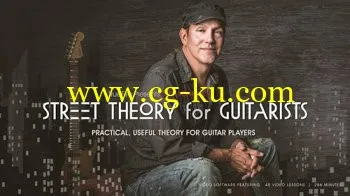
P2P | 29 July 2017 | 2.3 GB
Learning and applying music theory can be confusing and frustrating for guitar players. It’s such a vast subject with hundreds of general principles and concepts. Which ones are essential for you to know? How are they applied in a real world musical context? Which ones will have the most immediate impact on your playing and accelerate your growth as a musician?
Presented by Jeff Scheetz, TrueFire’s Director of Education, Street Theory for Guitarists answers all of those questions in plain language with demonstrations of each principle on the fretboard, specifically for guitarists. The course includes 5 hours of video instruction and a 123-page manual of charts, neck diagrams, tab and notation!
Jeff organized the course into four sections; Fundamentals, Chords, Scales, and Other Essential Theory. For each theoretical concept, Jeff will first explain the idea in clear and accessible language, and then demonstrate the concept on guitar to illustrate practical applications on guitar.
In the Fundamentals section, Jeff covers a range of foundational theoretical principles and clears up some of the most common terms that cause confusion. Topics include Confusing Terms, The Musical Alphabet, Note Names: 6th & 5th Strings, Finding Octaves, The Chromatic Scale, The Major Scale, Understanding Intervals, and Interval Position Shapes. Most of these concepts will connect to the theoretical principles presented in the following sections.
In the Chords section, Jeff presents all of the essential theory and practical applications of chords. Topics include: Building Chords, Root 5 and 6 Barre Shapes, Harmonized Scale, Roman Numerals & Progressions, 7th Chord Theory , Extended, Altered & Chord Subs, The Most Important Notes, Chords With Too Many Notes, What Key Is This Song In?, Modal Progressions & Tonal Centers, Inversions: Low Three Strings, Inversions: All Strings, Slash, Add, and Sus Chords, and Voice Leading.
In the Scales section, Jeff guides you through all of the essential Street Theory for scales and modes. If you’ve ever struggled to fully grasp how to navigate the fretboard, or improvise using scales or modes, this section alone is worth the price of admission. Topics include: Minor Pentatonic, Major Pentatonic, Pentatonic Application, The Blues Scale, 7 Major Scale Patterns, Modes: Parallel Scales Approach, Modes: Parent Scale Approach, Soloing With Modes, and Modes: Scale Pattern Approach.
In the Other Theory Essentials section, Jeff demonstrates more Street Theory principles to expand your soloing skills and understanding of the fretboard. Topics include: Arpeggios, Arpeggios Within Scales, Soloing With Arpeggios, Harmony Lines, Moving Harmonies, CAGED System Chords, Pentatonic Scales in CAGED, and Soloing in CAGED.
发布日期: 2017-07-30